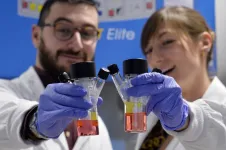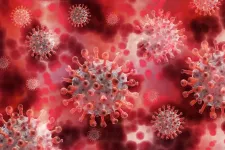(Press-News.org) INDIANAPOLIS -- A first-of-its-kind large-scale study of vegetation growth in the Northern Hemisphere over the past 30 years has found that vegetation is becoming increasingly water-limited as global temperatures increase.
The results are significant since vegetation is one of the biggest factors when it comes to controlling water and carbon cycling across Earth, which influences global temperatures. The work by IUPUI and Indiana University Bloomington researchers Wenzhe Jiao, END
Vegetation growth in Northern Hemisphere stunted by water constraints in warming climate
Shift may reduce plants' ability to absorb atmospheric CO2, increasing greenhouse gasses
2021-06-24
ELSE PRESS RELEASES FROM THIS DATE:
Primary lung cancers detected by LDCT are at lower risk of brain metastases
2021-06-24
(Denver)-Patients with primary lung cancer detected using low-dose computed tomography screening are at reduced risk of developing brain metastases after diagnosis, according to a study published in the Journal of Thoracic Oncology.
JTO is an official journal of the International Association for the Study of Lung Cancer. The full study is available here: Impact of Low-Dose Computed Tomography Screening for Primary Lung Cancer on Subsequent Risk of Brain Metastasis - Journal of Thoracic Oncology (jto.org)
The researchers, led by Summer Han, PhD, from Stanford University School of Medicine in Palo ...
A low Omega-3 index is just as strong a predictor of early death as smoking
2021-06-24
A new research paper published in the American Journal of Clinical Nutrition last week showed that a low Omega-3 Index is just as powerful in predicting early death as smoking. This landmark finding is rooted in data pulled and analyzed from the Framingham study, one of the longest running studies in the world.
The Framingham Heart Study provided unique insights into cardiovascular disease (CVD) risk factors and led to the development of the Framingham Risk Score based on eight baseline standard risk factors--age, sex, smoking, hypertension treatment, diabetes status, systolic blood pressure, total cholesterol (TC), and HDL cholesterol.
CVD is still the leading cause of death globally, and risk can be reduced by changing behavioral factors such as unhealthy diet, ...
New microscopy method reveals single childhood cancer cells in unprecedented detail
2021-06-24
A new technique to look at tumors under the microscope has revealed the cellular make-up of Wilm's tumors, a childhood kidney cancer, in unprecedented detail. This new approach could help understand how tumors develop and grow, and fuel research into new treatments for children's cancers.
Scientists at the Princess Máxima Center for pediatric oncology developed a new imaging technique and computational pipeline to study millions of cells in 3D tissue, revealing hundreds of features from each individual cell. Their research was published this month in Nature Biotechnology.
By offering a look at individual cells within an intact organ, the new technique helps scientists analyze the molecular profile of the cells, as well as their ...
Researchers find the adhesions that build the brain's networks
2021-06-24
DURHAM, N.C. - The brain's neurons tend to get most of the scientific attention, but a set of cells around them called astrocytes - literally, star-shaped cells - are increasingly being viewed as crucial players in guiding a brain to become properly organized.
Specifically, astrocytes, which form about half the mass of a human brain, seem to guide the formation of synapses, the connections between neurons that are formed and remodeled as we learn and remember.
A new study from Duke and UNC scientists has discovered a crucial protein involved in the communication and coordination between astrocytes as they build synapses. Lacking this molecule, called hepaCAM, astrocytes aren't as sticky as they ...
A 'tasty' protein may lead to new ways to treat metabolic and immune diseases
2021-06-24
GRAND RAPIDS, Mich. (June 24, 2021) -- The same taste-sensing molecule that helps you enjoy a meal from your favorite restaurant may one day lead to improved ways to treat diabetes and other metabolic and immune diseases.
TRPM5 is a specialized protein that is concentrated in the taste buds, where it helps relay messages to and from cells. It has long been of interest to researchers due to its roles in taste perception and blood sugar regulation.
Now, a team led by scientists at Van Andel Institute has published the first-ever high-resolution images of TRPM5, which reveal two areas that may serve as targets for new medications. The structures also may aid in the development of low-calorie alternative sweeteners that mimic sugar. The findings were published today in Nature ...
Collection of starshade research helps advance exoplanet imaging by space telescopes
2021-06-24
BELLINGHAM, Washington, USA - The open access Journal of Astronomical Telescopes, Instruments, and Systems (JATIS) has published END ...
Searching for the cell of origin of childhood brain cancer
2021-06-24
The study was conducted by an international collaboration involving the research team led by Luca Tiberi of the Armenise-Harvard Laboratory of Brain Cancer at the Department of Cellular, computational and integrative biology - Cibio of UniTrento, the Paris Brain Institute-Institut du Cerveau at Sorbonne Université in Paris, the Hopp Children´s Cancer Center (KiTZ) in Heidelberg, Germany, and Sapienza University in Rome. It was supported by Fondazione Armenise-Harvard, Fondazione Airc (Italian Association for Cancer Research) and Fondazione Caritro from Trento. The findings of the study, published in Science Advances, could lead to better and more effective treatments.
The team of researchers is proud of the results achieved. Luca Tiberi, coordinator of the study and corresponding ...
Scientists explain the behaviour of the optical emission of blazars
2021-06-24
Dmitry Blinov is a co-author of the article and Senior Research Associate in the Department of Astrophysics, St Petersburg University. He notes that researchers have been studying the optical polarisation from active galactic nuclei for more than 50 years. Some of the first academic papers on this topic were published back in the 1960s by Vladimir Hagen-Thorn, Professor in the Department of Astrophysics, St Petersburg University, and Viktor Dombrovskiy, Associate Professor in the Department of Astrophysics, Leningrad State University.
In the Universe, the main material is concentrated in galaxies with hundreds of billions of stars: there are about 200-400 of them in the Milky Way. At the centre of galaxies there are supermassive ...
Decoding humans' survival from coronaviruses
2021-06-24
An international team of researchers co-led by the University of Adelaide and the University of Arizona has analysed the genomes of more than 2,500 modern humans from 26 worldwide populations, to better understand how humans have adapted to historical coronavirus outbreaks.
In a paper published in Current Biology, the researchers used cutting-edge computational methods to uncover genetic traces of adaptation to coronaviruses, the family of viruses responsible for three major outbreaks in the last 20 years, including the ongoing pandemic.
"Modern human genomes contain evolutionary ...
Repurposing rheumatology drugs for COVID-19
2021-06-24
Rheumatologists are familiar with the everyday use of immunomodulatory drugs. These are designed to treat the inflammation caused by autoimmune diseases such as rheumatoid arthritis. A EULAR taskforce was set up to develop a set of new points to consider to give guidance and advice on the best way to use these medicines to treat COVID-19. The taskforce included rheumatologists, immunologists, haematologists, paediatricians, patients and other health professionals. They looked at the published evidence on the use of immunomodulatory therapies to treat severe COVID-19.
In total, there are two overarching principles and 14 points to consider. The principles stress that the picture of SARS-CoV-2 infection can be very different in different people. Infections range from asymptomatic ...
LAST 30 PRESS RELEASES:
Orthopedics can play critical role in identifying intimate partner violence
Worms as particle sweepers
Second spider-parasitic mite described in Brazil
January 2026 issues of APA journals feature new research on autism, pediatric anxiety, psychedelic therapy, suicide prevention and more
Private equity acquired more than 500 autism centers over the past decade, new study shows
New cervical cancer screening guidelines from the US Department of Health and Human Services
Estimated burden of COVID-19 illnesses, medical visits, hospitalizations, and deaths in the US from October 2022 to September 2024
Smartphone use during school hours by US youth
Food insecurity and adverse social conditions tied to increased risk of long COVID in children
Earliest, hottest galaxy cluster gas on record could change our cosmological models
Greenland’s Prudhoe Dome ice cap was completely gone only 7,000 years ago, first GreenDrill study finds
Scientific validity of blue zones longevity research confirmed
Injectable breast ‘implant’ offers alternative to traditional surgeries
Neuroscientists devise formulas to measure multilingualism
New prostate cancer trial seeks to reduce toxicity without sacrificing efficacy
Geometry shapes life
A CRISPR screen reveals many previously unrecognized genes required for brain development and a new neurodevelopmental disorder
Hot flush treatment has anti-breast cancer activity, study finds
Securing AI systems against growing cybersecurity threats
Longest observation of an active solar region
Why nail-biting, procrastination and other self-sabotaging behaviors are rooted in survival instincts
Regional variations in mechanical properties of porcine leptomeninges
Artificial empathy in therapy and healthcare: advancements in interpersonal interaction technologies
Why some brains switch gears more efficiently than others
UVA’s Jundong Li wins ICDM’S 2025 Tao Li Award for data mining, machine learning
UVA’s low-power, high-performance computer power player Mircea Stan earns National Academy of Inventors fellowship
Not playing by the rules: USU researcher explores filamentous algae dynamics in rivers
Do our body clocks influence our risk of dementia?
Anthropologists offer new evidence of bipedalism in long-debated fossil discovery
Safer receipt paper from wood
[Press-News.org] Vegetation growth in Northern Hemisphere stunted by water constraints in warming climateShift may reduce plants' ability to absorb atmospheric CO2, increasing greenhouse gasses




